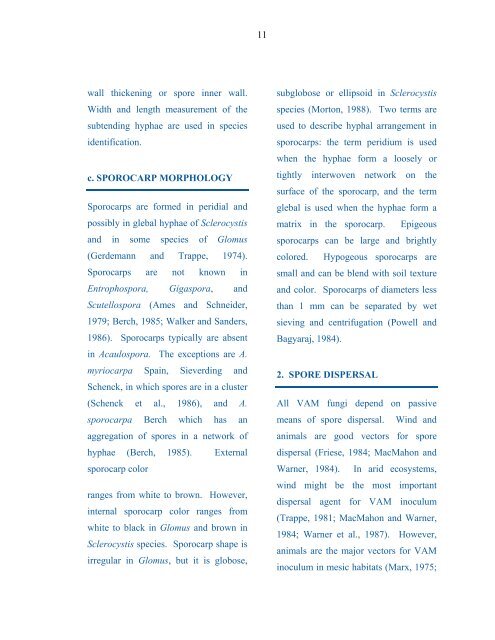10irregular, reniform, fusiform, <strong>and</strong> clavatein spores occur in VAM fungi. Sporecolor can range from hyaline to white topale yellow, orange, red, brown, darkbrown, or black. The differences incolor can be due to pigmentation in thespore wall or in the spore content(Morton, 1988).Traditionally,morphologicalcharacteristics of the spore walls ofVAM fungi are used in speciesidentification (Mosse <strong>and</strong> Bowen, 1968;Gerdemann <strong>and</strong> Trappe, 1974; Trappe,1982). Spore wall characteristicsbecame the most importantmorphological characteristic afterWalker (1983) suggested usingst<strong>and</strong>ardized terminology <strong>and</strong> wallmurographs. He originally proposedfour wall types, viz., the unit, laminated,evanescent, <strong>and</strong> membranous wall. Healso introduced the concept of a hyphalperidial wall. As new species weredescribed, new categories of spore wallswere added, i.e., the coriaceous wall byWalker (1986), the amorphous wall byMorton (1986), the exp<strong>and</strong>ing wall byBerch <strong>and</strong> Koske (1986), <strong>and</strong> thegerminal wall by Spain et al. (1989).b. SUBTENDING HYPHALMORPHOLOGYThe spores of most VAM fungi areproduced on one or more subtendinghyphae. Most Glomus species have asingle subtending hypha on their spore(Morton, 1988). Some species, such asG. glomerulatum Sieverding, G.halonatum Rose <strong>and</strong> Trappe, G.heterosporum Smith <strong>and</strong> Schenck, <strong>and</strong>G. lacteum Rose <strong>and</strong> Trappe producespores on 1-3 subtending hyphae. G.formosanum Wu <strong>and</strong> Chen <strong>and</strong> G.multisubtensum Mukerji, Bhattacharjee<strong>and</strong> Tewari form spores on 1-4subtending hyphae. The color ofsubtending hyphae in most species ofGlomus, Sclerocystis, Gigaspora, <strong>and</strong>Scutellospora is similar or lighter thanspore wall color. Subtending hyphalshapes range from straight, recurved,cylindrical, flared, funnel-shaped,constricted or irregular. The openingbetween the subtending hypha <strong>and</strong> thespore content may remain open or maybe closed by a plug, a septum, a spore-
11wall thickening or spore inner wall.Width <strong>and</strong> length measurement of thesubtending hyphae are used in speciesidentification.c. SPOROCARP MORPHOLOGYSporocarps are formed in peridial <strong>and</strong>possibly in glebal hyphae of Sclerocystis<strong>and</strong> in some species of Glomus(Gerdemann <strong>and</strong> Trappe, 1974).Sporocarps are not known inEntrophospora, Gigaspora, <strong>and</strong>Scutellospora (Ames <strong>and</strong> Schneider,1979; Berch, 1985; Walker <strong>and</strong> S<strong>and</strong>ers,1986). Sporocarps typically are absentin Acaulospora. The exceptions are A.myriocarpa Spain, Sieverding <strong>and</strong>Schenck, in which spores are in a cluster(Schenck et al., 1986), <strong>and</strong> A.sporocarpa Berch which has anaggregation of spores in a network ofhyphae (Berch, 1985). Externalsporocarp colorranges from white to brown. However,internal sporocarp color ranges fromwhite to black in Glomus <strong>and</strong> brown inSclerocystis species. Sporocarp shape isirregular in Glomus, but it is globose,subglobose or ellipsoid in Sclerocystisspecies (Morton, 1988). Two terms areused to describe hyphal arrangement insporocarps: the term peridium is usedwhen the hyphae form a loosely ortightly interwoven network on thesurface of the sporocarp, <strong>and</strong> the termglebal is used when the hyphae form amatrix in the sporocarp. Epigeoussporocarps can be large <strong>and</strong> brightlycolored. Hypogeous sporocarps aresmall <strong>and</strong> can be blend with soil texture<strong>and</strong> color. Sporocarps of diameters lessthan 1 mm can be separated by wetsieving <strong>and</strong> centrifugation (Powell <strong>and</strong>Bagyaraj, 1984).2. SPORE DISPERSALAll VAM fungi depend on passivemeans of spore dispersal. Wind <strong>and</strong>animals are good vectors for sporedispersal (Friese, 1984; MacMahon <strong>and</strong>Warner, 1984). In arid ecosystems,wind might be the most importantdispersal agent for VAM inoculum(Trappe, 1981; MacMahon <strong>and</strong> Warner,1984; Warner et al., 1987). However,animals are the major vectors for VAMinoculum in mesic habitats (Marx, 1975;
- Page 1 and 2: Taxonomy and EcologyOf Inland Sand
- Page 3 and 4: AbstractAgropyron inerme root syste
- Page 5 and 6: IntroductionInland sand dunes in Co
- Page 7 and 8: 3Literature Review"Mycorrhiza" is a
- Page 9 and 10: 5nonsporocarpic, and produced spore
- Page 11 and 12: 7Spores of VAM fungi are multinucle
- Page 13: 9germination shield is formed, andg
- Page 17 and 18: 13especially phosphate ions, some o
- Page 19 and 20: 15by the relative location of GOT a
- Page 21 and 22: 17D. DIFFICULTIES IN VAMFUNGAL TAXO
- Page 23 and 24: 19fungi are distributed over a wide
- Page 25 and 26: 21dune plants, the development of e
- Page 27 and 28: 23annually, a mean annual temperatu
- Page 29 and 30: 25C. EFFECTS OF SOIL DEPTH,MOISTURE
- Page 31 and 32: 27vegetated quadrats on each of the
- Page 33 and 34: 29Table 1 Occurrence of genera and
- Page 35 and 36: 31G. dominkii is the most abundant
- Page 37 and 38: 33abc d eFIG. 2 Glomus sp Light and
- Page 39 and 40: 35percent usually was strongly infl
- Page 41 and 42: 37FIG. 8 Regression of mycorrhizali
- Page 43 and 44: 39July transect data analyses (TABL
- Page 45 and 46: 41significantly with changes in the
- Page 47 and 48: 43FIG. 10 Regression of mycorrhizal
- Page 49 and 50: 45the July transect (FIG. 15). Howe
- Page 51 and 52: 47FIG. 17 Regression of mycorrhizal
- Page 53 and 54: 49C. COMPARISONS OF VAMCOLONIZATION
- Page 55 and 56: 51the survival strategies that adap
- Page 57 and 58: 53association with other species. T
- Page 59 and 60: 55believe the overriding factor is
- Page 61 and 62: 57my understanding of the ecology o
- Page 63 and 64: 59that soil characteristics and dis
- Page 65:
60AKNOWLEDGEMENTSI would like to ex
- Page 68 and 69:
61Allen, M. F., J. A. MacMahon, and
- Page 70 and 71:
63Bolgiano, N. C., G. R. Safir, and
- Page 72 and 73:
65mycorrhizal fungi: a determinant
- Page 74 and 75:
67Hayman, D. 1982. Influence of soi
- Page 76 and 77:
69Koske, R. E. 1985. Glomusaggregat
- Page 78 and 79:
71Morton, J. B. 1986. Three new spe
- Page 80 and 81:
73Powell, C. L., and D. J. Bagyaraj
- Page 82 and 83:
75Simon, L., M. Lalonde, and T. D.
- Page 84 and 85:
77Trappe, J. M. 1982. Synoptic keys
- Page 86:
79Wullstein, L. H., and S. A. Pratt


